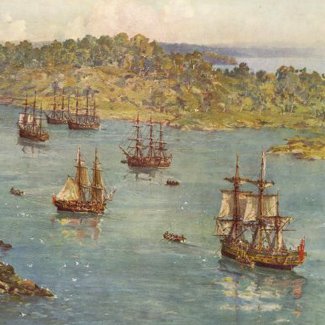First Fleet logs reveal climate patterns

LOG BOOKS FROM THE First Fleet are helping researchers to piece together the weather conditions endured on the epic journey.
The historic information will also be used to create a climate history of south-eastern Australia and may provied clues as to whether or not climate change is caused by humans.
Because official climate records have only been kept since about 1910, understanding of longer-term weather patterns has been limited, making it difficult to distinguish natural climate trends from human induced climate change, said lead researcher Dr Joëlle Gergis from the University of Melbourne.
“There’s a quote that I often like to use that I think really sums up the work that all of us are trying to do. And that is: ‘the further back you look, the further forward you can see’,” she told reporters at an online press conference on Thursday.
With the help of the Bureau of Meteorology, along with researchers at the National Library of Australia and state libraries around the country, Joëlle and colleagues are piecing together information from government gazettes, hundreds of old newspapers, barometric pressure readings and pastoral records to identify past climate trends and understand how this affected Australia’s settlement.
“It’s a really overlooked area of research in Australia,” says Joëlle. “It’s the first time we’re really getting an opportunity to look at what the weather was doing from 1788.”
Harrowing weather
Aside from the climate data, Joëlle is also interested in the personal stories her work has uncovered. She says accounts by officers and passengers aboard the First Fleet – such as that from HMS Sirius Lieutenant William Bradley, who kept a logbook of barometric pressure readings and prevailing weather patterns – show the fleet encountered cold weather and snow as they rounded Tasmania.
The ships were “hammered by really severe winds … that left them praying for their lives”, as they sailed north along the eastern seaboard towards Port Jackson and Botany Bay,” says Joëlle. “It would have been pretty harrowing by anyone’s standards,”
The first years of European settlement in Australia were marked by extreme wet weather in which the settlers experienced flooding on a number of occasions. Yet by 1791, says Joëlle, they were locked in the grip of a drought in which masses of flying foxes and birds were recorded falling dead from the trees due to the searing heat. “Up to 20,000 of them were seen in the space of a mile,” she says.
The study is one of a number being discussed at a conference in New Zealand, held as part of a global effort to recover lost weather data from the past that participants say promises a wealth of possibilities.
“If we can reconstruct weather over several hundred years, [imagine] what people could use them for,” says Dr Rob Allan, who manages the International Atmospheric Reconstructions over the Earth Initiative in London.
The conference, held in New Zealand this week, is also showcasing imaging techniques, including a Google Earth animation showing the difficult weather conditions experienced by the First Fleet.
RELATED STORIES

